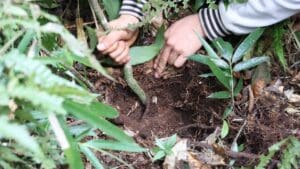The Kadsura Dragon™ Vine grows best in soils with moderate fertility, well-drained with neutral to acid soil, produce the fastest growth.
It does excellent in semi-shade even deep shade.
 The roots of the Kadsura Dragon™ Vine tend to be shallow like kiwis, and since its native habitat receives rain in the summertime they benefit from deep mulching in arid climates.
The roots of the Kadsura Dragon™ Vine tend to be shallow like kiwis, and since its native habitat receives rain in the summertime they benefit from deep mulching in arid climates.
The roots tend to grow in the top one or 2 feet of the soil so they should not be tilled close to the plant or fertilized too heavily.
Weak acidic sandy loam is the most suitable for planting.
Moisture Levels for Growing the Kadsura Dragon™ Vine
If possible, the soil should be kept moist during the growing season, especially for smaller plants. Larger plants can take weeks of drought.
We have seen these plants handle several weeks of drought in summer and even a couple of months of drought during winter dormancy. The vines, with their aromatic roots, are fleshy and rebound quickly once water is applied. For the largest fruit, moisture is preferred evenly through a dry hot season.
They are not particularly demanding on what soil type they have, but sandy loam soil is the most suitable and creates the fastest growth. They often do well planted under peaches, plums, persimmons, pears, apples, or grapes. They can also be grown as bonsai.
In Southern States of the USA they can be planted anywhere from October through May. In colder northern states of the U.S., they should be planted anytime from early spring until late summer.
Planting multiple plants in the same vicinity can greatly enhance pollination and increase yield.
Diverse plantings are suitable to many locations in the yard or directly in a forested region
Kasdura Dragon™ Vine plants are suitable on steep hills under deciduous or even evergreen trees.
The roots gradually spread out from the stock and grow well in shallow or deep.
Planting on steep mountain slopes, climbing over a tree are the natural habitat for them.
When planting in an orchard the hole does not have to be too deep or too wide. Kadsura will benefit from loose soil with heavy much or leaf matter on top of the ground.
Do not plant them in water-logged soil. Although the roots can handle standing water for a short time, a raised bed or ridge for better drainage can be made if the soil is boggy and wet for long periods of time.
Fertilizing regiment
The plants like natural sources of calcium, magnesium and phosphorus mixed into the soil. Compost and leaf matter is suitable and the fruits do well under organic cultivation, which is highly preferred.